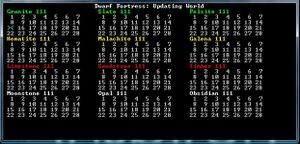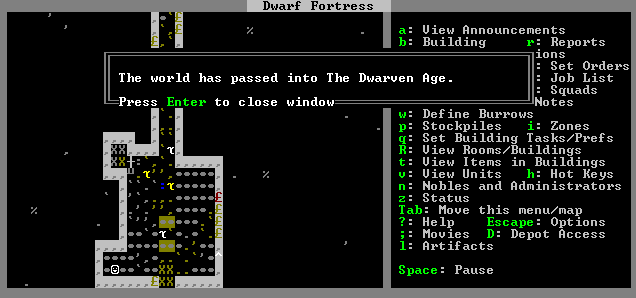- v50 information can now be added to pages in the main namespace. v0.47 information can still be found in the DF2014 namespace. See here for more details on the new versioning policy.
- Use this page to report any issues related to the migration.
DF2014:Calendar
| This article is about an older version of DF. |
The dwarven calendar is used to display the day, month, and year of any given date, and is visible in the upper right corner of the status screen (z). During game-play in fortress mode, however, the layout of the date is YY-MM-DD. There are 12 months in the dwarven year, divided into 4 seasons of 3 months each. Unlike the traditional Gregorian calendar, each dwarven month is exactly 4 weeks long, or 28 days, for a total of 336 days in a year. New Year's Day and the first day of Spring both fall on the 1st of Granite. New Year's Eve and the last day of Winter both fall on the 28th of Obsidian. The months are named after kinds of stones, ore, gems and wood.
The game's first playable year begins whenever the world stops generating - by default, this will be year 250. Worldgen can be set to stop at several distinct years ranging from 5 to 1050 when selecting Create a World, and can also be set to any arbitrary year by editing the advanced option End Year in the Design New World with Advanced Parameters screen, or by interrupting world generation.
Months and seasons[edit]
The world follows a seasonal cycle - each season affects the climate, the crops that can be farmed, and the ebb and flow of trade. There are also full moons on certain fixed dates every year, during which werebeasts will transform into their werebeast form on these days.
| Month | Gregorian equivalent | Season | Caravan | Full Moon | ||||
|---|---|---|---|---|---|---|---|---|
| Northern Hemisphere | Southern Hemisphere | |||||||
•
|
1 | Granite | March | September | Early- | Spring | Elven | 25th |
•
|
2 | Slate | April | October | Mid- | 23rd | ||
•
|
3 | Felsite | May | November | Late- | 21st | ||
*
|
4 | Hematite | June | December | Early- | Summer | Human | 19th |
*
|
5 | Malachite | July | January | Mid- | 17th | ||
*
|
6 | Galena | August | February | Late- | 15th | ||
•
|
7 | Limestone | September | March | Early- | Autumn | Dwarven | 13th |
•
|
8 | Sandstone | October | April | Mid- | 10th | ||
▬
|
9 | Timber | November | May | Late- | 8th | ||
♦
|
10 | Moonstone | December | June | Early- | Winter | None* | 6th |
♦
|
11 | Opal | January | July | Mid- | 4th | ||
•
|
12 | Obsidian | February | August | Late- | 2nd and 28th | ||
* If you have modded the game to not be at war with the goblins or kobolds, then they will send caravans to you, and you will be able to trade with them, but only if you have also modded them to have pack animals or wagon pullers. If you do, then they will send caravans every season, including winter.
Seasonal effect on Farming[edit]
The seasons correspond to growing seasons from the farm plot q menu, which dictate what can be grown when during the year. (See the list of crops.) It should be noted that crops grow during seasons regardless of the actual weather, so any crops that grow during the spring will do so regardless of how much rain your area gets.
Seasonal effect on Trading[edit]
Civilizations will visit your fortress based on what season it currently is. Trade caravans for each race show up during the specific seasons each year, with the elves arriving during the Spring, the humans during the Summer, and the dwarves during the Autumn. No caravans arrive for the winter, so it's smart to stock up on food and drink during the fall.
Ages[edit]
In addition to the year, a world's history is also divided into ages. An age can be seen as an epoch, something which defines the period of years it describes. The age itself has no bearing on gameplay other than as categorization in Legends mode, though players may witness a change in age (with an accompanied announcement) should their actions cause the current age to end. This may happen after killing a large number of megabeasts.
Ages are determined by the states of the world during world generation. Worlds start in the Age of Myth, though this may not always hold true if changes to world gen parameters are made. Some of the known things that influence the ages are number of megabeasts currently living and dominant civilizations. It is also possible for a world to enter a particular Age more than once (e.g., The Second Age of Legends) if the appropriate conditions are met.
Known Ages[edit]
Below is a list of 'Ages' that may occur, an explanation and their (possible) triggers, and their in-game descriptions. World size may affect how long an age lasts. Because the age is dependent on variables such as number of megabeasts, number of civilized creatures, etc., smaller worlds will tend to change ages more frequently. Conversely, larger worlds tend to be more age-stable.
Great Powers in Control[edit]
This course of this period is shaped by the Great Powers; historical figures with the [POWER] or [MEGABEAST]/[TITAN] creature tokens. If there are more than 3 powers in a world when it begins, then it will progress through the ages of Myth, Legends, and Heroes; if 3 or fewer, then it will progress through the various Ages of Powers.
|
The Age of Myth: The number of living powers and megabeasts is at least 2/3 of what it was when the world began.
The Age of Legends: The number of living powers and megabeasts is at least 1/3 of what it was when the world began.
The Age of Heroes: The number of living powers and megabeasts is greater than three.
|
In larger worlds, the proliferation (and extermination) of necromancers, vampires, and werebeasts during world generation can cause the age to "regress" back to Heroes, Legends, or, in slightly extreme cases, even Myth, sometimes multiple times.
If a world starts with 3 powers and manages to progress beyond that, it will proceed to the Age of Myth.
|
The Age of Three Powers: Exactly three powers are alive in the world.
The Age of Two (Race)s or The Age of (Race) and (Race): Exactly two powers are alive in the world.
The Age of (Name/Species): Exactly one power is alive in the world. The name style is selected randomly.
|
No Great Powers[edit]
Once the Great Powers have fallen, the status of mortal civs will determine the Age. The ages will proceed as follows.
|
The Age of (Race) or The (Racial) Age: Less than 50% of all civilized creatures are mundane, and the majority are of one race. The name style is selected randomly.
The Golden Age: Less than 50% of all civilized creatures are mundane, but there is no single majority.
The Twilight Age: Between 50% and 90% of all civilized creatures are mundane.
The Age of Fairy Tales: Over 90% of all civilized creatures are mundane, but some non-mundane ones still remain.
|
Toady One's quote from 2008 devlog: "I finally saw a world arrive at the Age of Fairy Tales, which happens if mundane creatures (ie humans) make up at least 90% of the world's civilized population with the requirement that there are still a few fantasy creatures lurking around. In this case, it was a kobold cave that their scouts never found. I guess all of the fairy tales were about people having their crap stolen."
|
The Age of Civilization: All civilized creatures are mundane, and all semi-megabeasts have been vanquished.
The Age of Death: All civilized creatures are dead, and the world has passed through at least one Age of Twilight, Age of Fairy Tales, Age of (Race), Golden Age, or Age of Civilization.
The Age of Emptiness: All civilized creatures are dead, but the world never progressed beyond the Ages of Myth, Legends, Heroes, or Powers (i.e. all civilized creatures were wiped out before all powers).
|
A world that ends generation in the Age of Death or Emptiness will only allow games to be started in Legends mode or Adventurer mode.
Within the string dump, beneath these ages, are the following three lines:
- Unknown Age
- Monster
- Rampage
It is unclear what these are used for.
Announcements[edit]
A change in the season will generate an announcement. Depending on the biome your fortress is in, the announced season may be different from the calendar season. For example, in some biomes "wet" and "dry" seasons replace spring or summer. A few biomes lack any change in weather and those biomes announce a change of season by "-season- has arrived on the calendar." Regardless, plants and caravans always follow the calendar season listed on the status screen.
Worlds | |||||||||
|---|---|---|---|---|---|---|---|---|---|
| General | |||||||||
| Map |
| ||||||||
| Civilization |
| ||||||||


